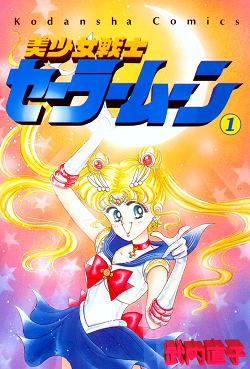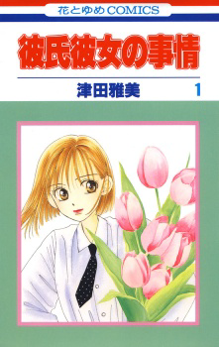This article needs additional citations for verification .(December 2009) |
Tokyopop, originally named MixxZine, was a manga anthology published in North America by Tokyopop.
This article needs additional citations for verification .(December 2009) |
Tokyopop, originally named MixxZine, was a manga anthology published in North America by Tokyopop.
MixxZine at the start published five manga series, two of which were shōjo (geared towards young or teenaged girls) and two of which were seinen (geared towards adolescent boys/men):
Sailor Moon was taken out of the anthology and moved to Smile , as the seinen and shōjo content were hard to reconcile due to the vast difference in audiences, [1] and as Mixx wanted to refocus the magazine towards high school and university/college-aged readers [2] which focused more on shōjo titles.
When MixxZine was renamed Tokyopop in July 1999, the focus changed towards more information on Asian culture, [3] along with manga and articles on J-pop, video games, and anime. The magazine was offered for free, [4] and only a few manga titles were published in the magazine, rotating through the following titles: [5]
Tokyopop was eventually discontinued in August 2000. [6]

Manga are comics or graphic novels originating from Japan. Most manga conform to a style developed in Japan in the late 19th century, and the form has a long history in earlier Japanese art. The term manga is used in Japan to refer to both comics and cartooning. Outside of Japan, the word is typically used to refer to comics originally published in Japan.

Sailor Moon is a Japanese manga series written and illustrated by Naoko Takeuchi. It was originally serialized in Kodansha's shōjo manga magazine Nakayoshi from 1991 to 1997; the 60 individual chapters, along with several side stories, were compiled in 18 volumes. The series follows the adventures of a schoolgirl named Usagi Tsukino as she transforms into the eponymous character to search for a magical artifact, the "Legendary Silver Crystal". She leads a group of comrades, the Sailor Soldiers, called Sailor Guardians in later editions, as they battle against villains to prevent the theft of the Silver Crystal and the destruction of the Solar System.

Yuri, also known by the wasei-eigo construction girls' love, is a genre of Japanese media focusing on intimate relationships between female characters. While lesbian relationships are a commonly associated theme, the genre is also inclusive of works depicting emotional and spiritual relationships between women that are not necessarily romantic or sexual in nature. Yuri is most commonly associated with anime and manga, though the term has also been used to describe video games, light novels, and literature.

Magic Knight Rayearth is a Japanese manga series created by CLAMP. Appearing as a serial in the manga magazine Nakayoshi from the November 1993 issue to the February 1995 issue, the chapters of Magic Knight Rayearth were collected into three bound volumes by Kodansha. They were published from July 1994 to March 1995. A sequel was serialized in the same manga magazine from the March 1995 issue to the April 1996 issue. It was published by Kodansha in three bound volumes from July 1995 to April 1996.

Kare Kano is a Japanese manga series written and illustrated by Masami Tsuda. It was serialized in LaLa from 1995 to 2005 and collected in 21 tankōbon volumes by Hakusensha. It depicts the romance between "perfect" student Yukino Miyazawa and her academic rival Soichiro Arima, and the relationships of several of their friends.

Tokyopop is an American distributor, licensor and publisher of anime, manga, manhwa and Western manga-style works. The German publishing division produces German translations of licensed Japanese properties and original English-language manga, as well as original German-language manga. Tokyopop's US publishing division publishes works in English. Tokyopop has its US headquarters near Los Angeles International Airport in Los Angeles, California. Its parent company's offices are in Tokyo, Japan and its sister company's office is in Hamburg, Germany.

Parasyte is a Japanese science fiction horror manga series written and illustrated by Hitoshi Iwaaki. It was published in Kodansha's Morning Open Zōkan (1989) and Monthly Afternoon. The manga was published in North America first by Tokyopop, then Del Rey, and finally Kodansha USA. The series follows Shinichi Izumi, a high school senior who is the victim of a failed attempt by a parasitic organism to take over his brain. The parasite instead infects and takes over his arm.

Ice Blade is a Japanese manga series written and illustrated by Tsutomu Takahashi. It was serialized in Kodansha's seinen manga magazine Monthly Afternoon from 1992 to 1999, with its chapters collected in nineteen tankōbon volumes. The story follows Kyoya Ida, a plainclothes police officer, and his colleagues at the Shinjuku Police Department as they investigate and solve crimes in the Greater Tokyo Area. Sometimes, these crimes are solved with some prices to pay.
Yukiru Sugisaki is a Japanese manga artist. She has created numerous manga in several demographics, but is perhaps best known for creating the seinen series The Candidate for Goddess and the shōjo series D.N.Angel.

Syaoran Li, sometimes spelled as Shaoran Li or originally as Xiaolang Li, is one of the central characters in the Clamp manga Cardcaptor Sakura and its sequel Cardcaptor Sakura: Clear Card. In the English anime adaptation by Nelvana of the series, Cardcaptors, he was renamed Li Showron and in the American broadcast was rewritten to be the joint main protagonist alongside Sakura Kinomoto, despite Sakura's solo lead role in all other regional conversions. Syaoran is a young Chinese sorcerer from Hong Kong, descending from Clow Reed and appearing in Tokyo during his introduction in order to capture the missing cards released by Sakura. Although Syaoran is initially apprehensive towards the protagonist due to their shared goal, he, in time, finds himself falling in love with her as the series progresses. Syaoran's relationship with Sakura is further explored in the 2000 Cardcaptor Sakura Movie 2: The Sealed Card film and the sequel.
Smile was a magazine aimed at teenage girls. The magazine was started in 1998. At first it was supposed to be a mainstream teen mag similar to Seventeen, but with added manga; later, it became more focused on manga and removed most of its other features. It was published by Tokyopop based in Los Angeles. The magazine was discontinued in 2002.
Manga, or comics, have appeared in translation in many different languages in different countries. France represents about 40% of the European comic market and in 2011, manga represented 40% of the comics being published in the country. In 2007, 70% of the comics sold in Germany were manga. In the United States, manga comprises a small industry, especially when compared to the inroads that Japanese animation or Japanese video games have made in the USA. One example of a manga publisher in the United States, VIZ Media, functions as the American affiliate of the Japanese publishers Shogakukan and Shueisha. Though the United Kingdom has fewer manga publishers than the U.S., most manga sold in the United Kingdom are published by U.S. publishing companies like Viz media and Kodansha Comics which are in turn owned by their Japanese counterparts. Alongside the United Kingdom, the U.S. manga publishers also sell their English translated manga in other English speaking nations like Canada, Australia and New Zealand with manga being quite popular in Australia compared to other English speaking countries.

Planet Ladder is a Japanese manga series written and illustrated by Yuri Narushima. Appearing as a serial in the shōjo manga magazine Crimson from the March 1998 issue to the May 2003 issue, the chapters of Planet Ladder were published by Sobisha/Shueisha in seven tankōbon volumes from December 1998 to May 2004. Based on the Japanese folktale The Tale of the Bamboo Cutter in which a girl is discovered to be the princess of the moon, the story focuses on a teenager named Kaguya, who is prophesied to save only one of the nine parallel worlds, and her quest to bring peace to a warring universe while finding her true identity.

Manga, in the sense of narrative multi-panel cartoons made in Japan, originated from Euro-American-style cartoons featured in late 19th-century Japanese publications. The form of manga as speech-balloon-based comics more specifically originated from translations of American comic strips in the 1920s; several early examples of such manga read left-to-right, with the longest-running pre-1945 manga being the Japanese translation of the American comic strip Bringing Up Father. The term manga first came into usage in the late 18th century, though it only came to refer to various forms of cartooning in the 1890s and did not become a common word until around 1920.
Gutsoon! Entertainment, Inc. was a publisher of English translated manga. The company, headquartered in Encino, Los Angeles, served as the US subsidiary of Coamix, which was founded by Nobuhiko Horie and manga artist Tsukasa Hojo.
Jump, also known as Jump Comics, is a line of manga anthologies created by Shueisha. It began with Shōnen Jump manga anthology in 1968, later renamed Weekly Shōnen Jump. The origin of the name is unknown. The Jump anthologies are primarily intended for male audiences, although the Weekly Shōnen Jump magazine has also been popular with the female demographic. Along with the line of manga anthologies, Shōnen Jump also includes a crossover media franchise, where there have been various Shōnen Jump themed crossover anime and video games, which bring together various Shōnen Jump manga characters.
{{cite web}}: CS1 maint: unfit URL (link)